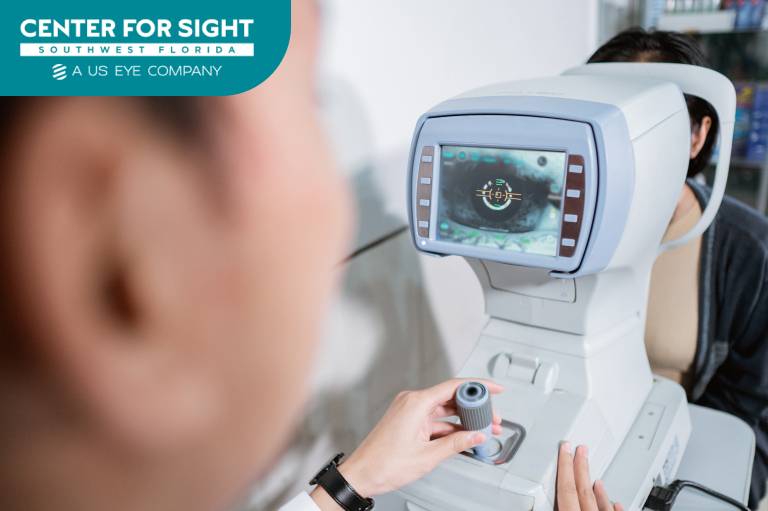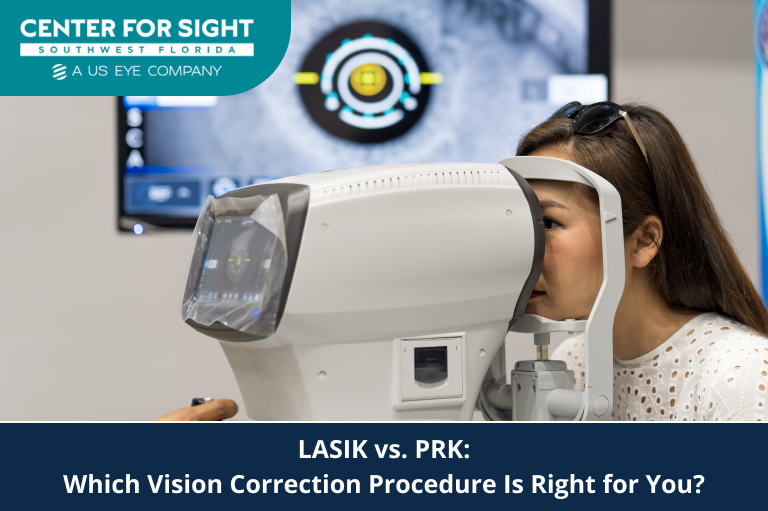Reviewed By: Dr. George Brinnig, MD.
Do you find yourself still relying on glasses or contacts to see the world clearly? You’re not alone—over 164 million Americans wear some form of vision correction every day. That’s nearly half the U.S. population.
But let’s be honest…
Glasses fog up. Contacts dry out. And the cost of keeping up with both? It adds up fast—about $500–$700 a year per person. Over a decade, that’s the price of a decent used car.
So what’s the alternative?
More than 10 million people in the U.S. have already chosen laser vision correction, with LASIK and PRK leading the charge. These procedures can give you 20/20 vision or better—often in under 30 minutes—with no glasses, no contacts, and no daily maintenance.
But here’s the catch: LASIK treatment isn’t right for everyone. PRK isn’t either.
So how do you choose?
In this complete guide, we’ll break down laser eye surgery options PRK vs LASIK and most importantly: how to know which is right for you.
What Is LASIK Treatment?
LASIK stands for Laser-Assisted In Situ Keratomileusis. It’s the most common form of laser eye surgery in the U.S., with over 600,000 procedures performed annually.
What it does: It corrects vision problems like nearsightedness, farsightedness, and astigmatism by reshaping the cornea.
How it works:
- A surgeon creates a thin flap in the cornea.
- A precision laser reshapes the corneal tissue underneath.
- The flap is gently replaced—no stitches needed.
What to expect:
- Painless procedure (about 10–15 minutes per eye)
- Clearer vision often within 24 hours
- Most patients return to work within 1–2 days
LASIK is ideal if you:
- Have a stable vision prescription
- Have thick enough corneas
- Want a fast recovery
- Prefer minimal discomfort
If you struggle with contact lens discomfort, you might find this post on LASIK for contact lens intolerance helpful.

What Is PRK?
PRK, or Photorefractive Keratectomy, is another FDA-approved laser vision correction method. It was actually developed before LASIK—and it’s still widely used today, especially for people who aren’t LASIK candidates.
How PRK is different:
- Instead of creating a corneal flap, the top layer of the cornea (epithelium) is removed completely.
- A laser reshapes the cornea underneath, just like in LASIK.
- A special bandage contact lens is placed over the eye to protect it during healing.
PRK is ideal if you:
- Have thinner corneas
- Have dry eyes or irregular corneas
- Work in high-risk environments (e.g., military, police, contact sports)
PRK vs LASIK: Side-by-Side Comparison
Let’s make this simple. Here’s how LASIK treatment and PRK stack up:
| Factor | LASIK | PRK |
| Corneal flap | Yes | No |
| Ideal for thin corneas | No | Yes |
| Procedure time | ~15 mins/eye | ~15 mins/eye |
| Pain after surgery | Mild | Moderate (for 2–3 days) |
| Vision improvement | 24–48 hours | 3–5 days |
| Back to work | 1–2 days | 5–7 days |
| Long-term results | Excellent | Excellent |
| Flap-related risks | Possible | None |
| Cost | Similar | Similar |
Key Differences Between PRK and LASIK: Why LASIK May Be the Better Choice
At a glance, LASIK and PRK might sound similar—they both use lasers to reshape the cornea and correct vision. But under the surface, the differences matter—especially when it comes to comfort, convenience, and lifestyle.
Let’s break down the key differences that actually affect your daily life:
1. Surgical Technique: Flap vs. No Flap
- LASIK: A thin corneal flap is created using a femtosecond laser, then lifted to reshape the underlying tissue.
- PRK: The outer layer of the cornea is gently removed, and the laser reshapes the exposed surface directly—no flap involved.
Why it matters: LASIK’s flap technique allows for faster healing and less discomfort. PRK is better for people with thinner corneas or those at risk of eye trauma (e.g., military or contact sports).
2. Recovery Time and Comfort
- LASIK: Most people return to normal vision within 24–48 hours. Minimal discomfort.
- PRK: Recovery takes 3–7 days, often with moderate discomfort and blurred vision during the first week.
Why it matters: LASIK patients typically bounce back faster, return to work sooner, and experience less downtime overall.
3. Visual Results Timeline
- LASIK: Clear vision is often achieved by the next day.
- PRK: Vision improves more slowly—often over several days or even weeks.
Why it matters: If your schedule is tight or you rely on your vision for work (driving, screens, public interaction), LASIK gives you a quicker payoff.
4. Post-Surgery Restrictions
- LASIK: Some activity restrictions (e.g., rubbing eyes, swimming) for about a week.
- PRK: Requires protective lenses and longer healing time, with more follow-up care in early recovery.
Why it matters: For most patients, LASIK’s faster return to normal life is a major advantage—especially for parents, professionals, or students.
5. Long-Term Safety and Stability
- Both LASIK and PRK offer excellent long-term outcomes with a high success rate.
- PRK avoids flap-related complications—but modern LASIK technology has reduced those risks to less than 1%.
Why it matters: Unless you have very thin corneas or a risky job environment, LASIK offers the same safety benefits—with a smoother journey from start to finish.
Who Qualifies for Laser Eye Surgery?
Here’s what doctors typically check before recommending laser eye surgery options:
- Age: You must be 18 or older.
- Prescription stability: No major changes in vision for at least 12 months.
- Eye health: No severe dry eye, infections, or corneal scarring.
- General health: No autoimmune diseases or uncontrolled diabetes.
- Corneal thickness: Measured with precise imaging tools.
Bonus tip: Don’t self-diagnose. A 15-minute evaluation with an expert will give you more accurate answers than hours of online research.
Understanding the Recovery Process
LASIK Recovery:
- Vision improves within 24–48 hours.
- Mild dryness, light sensitivity, or halos around lights (temporary).
- Avoid rubbing eyes, swimming, or heavy workouts for a few days.
PRK Recovery:
- Discomfort for 2–3 days (usually managed with eye drops and rest).
- Blurry vision for the first week.
- Bandage contact lens removed after ~5 days.
- Vision continues to improve over 2–4 weeks.
Both procedures lead to similar long-term results—but PRK takes a bit longer to get there.
Are There Any Risks?
All surgery carries some risk. With modern laser eye surgery technology, complications are rare—but here’s what you should know:
Common side effects (short-term):
- Dry eyes
- Glare or halos at night
- Temporary visual fluctuations
Rare risks (long-term):
- Infection
- Overcorrection or undercorrection
- Need for enhancement (about 1–2% of cases)
Choosing a trusted provider dramatically reduces these risks.
How Much Does LASIK or PRK Cost?
In the U.S., the average cost ranges from $2,000 to $3,000 per eye for either LASIK treatment or PRK. Prices vary depending on:
- Surgeon experience
- Technology used (blade-free vs. traditional)
- Pre- and post-op care included
Insurance usually doesn’t cover it, since it’s considered elective. But:
- HSA/FSA funds can often be used
- Payment plans are usually available
- Lifetime benefits make it cost-effective over time
Think about it this way: if you spend $500/year on glasses, contacts, and exams, your surgery pays for itself in 4–5 years.
Effectiveness and Long-Term Outcomes
So what kind of results can you actually expect from LASIK or PRK?
Both procedures are highly effective, with over 96% of patients achieving 20/20 vision or better. But there are subtle differences in experience, recovery, and long-term stability—and those can matter depending on your lifestyle and eye health.
LASIK Outcomes
- Fast results: Most patients see clearly within 24–48 hours.
- High satisfaction rates: Studies show up to 98% patient satisfaction—one of the highest for any elective surgery.
- Vision clarity: Often sharper earlier due to quicker healing and flap preservation.
- Night vision: Newer laser technologies significantly reduce past issues like glare, halos, and double vision, especially in low-light settings.
- Long-term stability: Most patients enjoy clear vision for 10+ years without additional procedures.
In some cases, a minor enhancement may be needed years later due to natural aging—but that’s true for both LASIK and PRK.
PRK Outcomes
- Excellent long-term vision—comparable to LASIK once healing completes.
- Slower improvement: It may take a few weeks to fully reach 20/20 clarity.
- More healing time means a longer wait before night vision stabilizes.
- No corneal flap: Safer for patients with thinner corneas, but it also means slightly more discomfort early on.
Dry Eye Syndrome & Healing
- LASIK patients may experience temporary dry eye, especially in the first 3–6 months.
- PRK patients tend to avoid severe dry eye but may deal with longer light sensitivity and inflammation.
- Most symptoms are temporary and resolve with standard eye drops and care.
If you’re a good candidate for both, LASIK often offers faster recovery, earlier visual clarity, and less day-to-day disruption, making it the more popular choice overall.
But if your eyes don’t meet LASIK requirements (like thin corneas), PRK delivers the same high-quality vision, just on a slightly longer timeline.
Next Steps: What You Should Do Now
✔️ Check your eye health (schedule a full evaluation)
✔️ Discuss your lifestyle, vision goals & career
✔️ Ask if you’re eligible for enhancement surgery or if you need artificial tear therapy for dry eye
✔️ Learn the difference between standard and EagleVision LASIK technologies
Your Next Step: Get a Personalized Consultation
Here’s the truth: both LASIK treatment and PRK work.
They’re both safe. They’re both backed by decades of clinical results. And they both offer the kind of freedom that changes your daily life in ways you won’t believe until you experience it.
Imagine waking up and being able to read the clock across the room.
Jumping into the ocean without worrying about your contacts.
Driving at night without glare—or taking a selfie without your glasses reflecting the flash.
Sound small? Maybe.
But ask the millions of people who’ve had laser vision correction, and you’ll hear the same thing: It’s one of the best decisions they ever made.
At Center For Sight, we’ve helped thousands of patients across Southwest Florida ditch their glasses, stop relying on contacts, and experience life with crystal-clear vision. Whether laser eye surgery options LASIK or PRK is right for you, our team will walk you through the safest, most effective path forward.
So here’s the real question: If a 20-minute procedure could give you years—or decades—of better vision, wouldn’t you at least want to know if you qualify?
Contact us today to schedule your personalized consultation. Let’s find out together whether LASIK or PRK is your path to seeing clearly again without compromise.



